Group Career Guidance Activity: Autism Spectrum Disorder in K-3 Grade
VerifiedAdded on 2022/08/13
|7
|1379
|12
Report
AI Summary
This report details a group career guidance activity designed for children with Autism Spectrum Disorder (ASD), focusing on children in grades K-3. It discusses the target population, developmental stages, and career competencies suitable for individuals with ASD, such as those involving routine tasks and limited stimuli. The report outlines a group intervention plan that includes activities encouraging children to develop career plans, organize information, and express themselves, enhancing verbal expression and empathy. Additionally, the plan involves interactive sessions with parents to improve their understanding of their child's career and learning needs. The report emphasizes the importance of continuous screening, assessment using diagnostic evaluation, and collaboration between parents and teachers to create customized teaching plans for ensuring lifelong behavioral and learning outcomes in children with ASD. References to relevant research are included to support the proposed strategies.
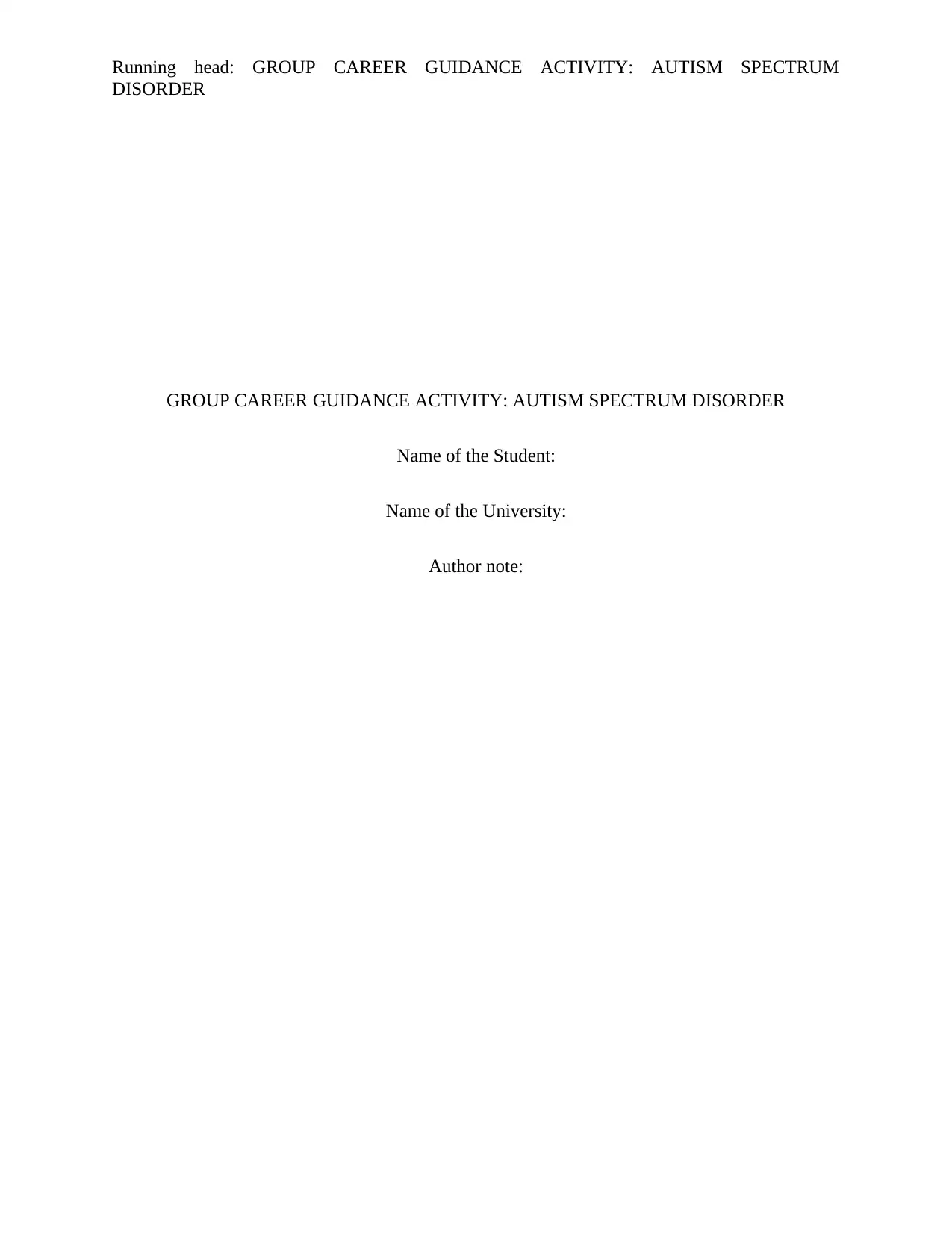
Running head: GROUP CAREER GUIDANCE ACTIVITY: AUTISM SPECTRUM
DISORDER
GROUP CAREER GUIDANCE ACTIVITY: AUTISM SPECTRUM DISORDER
Name of the Student:
Name of the University:
Author note:
DISORDER
GROUP CAREER GUIDANCE ACTIVITY: AUTISM SPECTRUM DISORDER
Name of the Student:
Name of the University:
Author note:
Paraphrase This Document
Need a fresh take? Get an instant paraphrase of this document with our AI Paraphraser
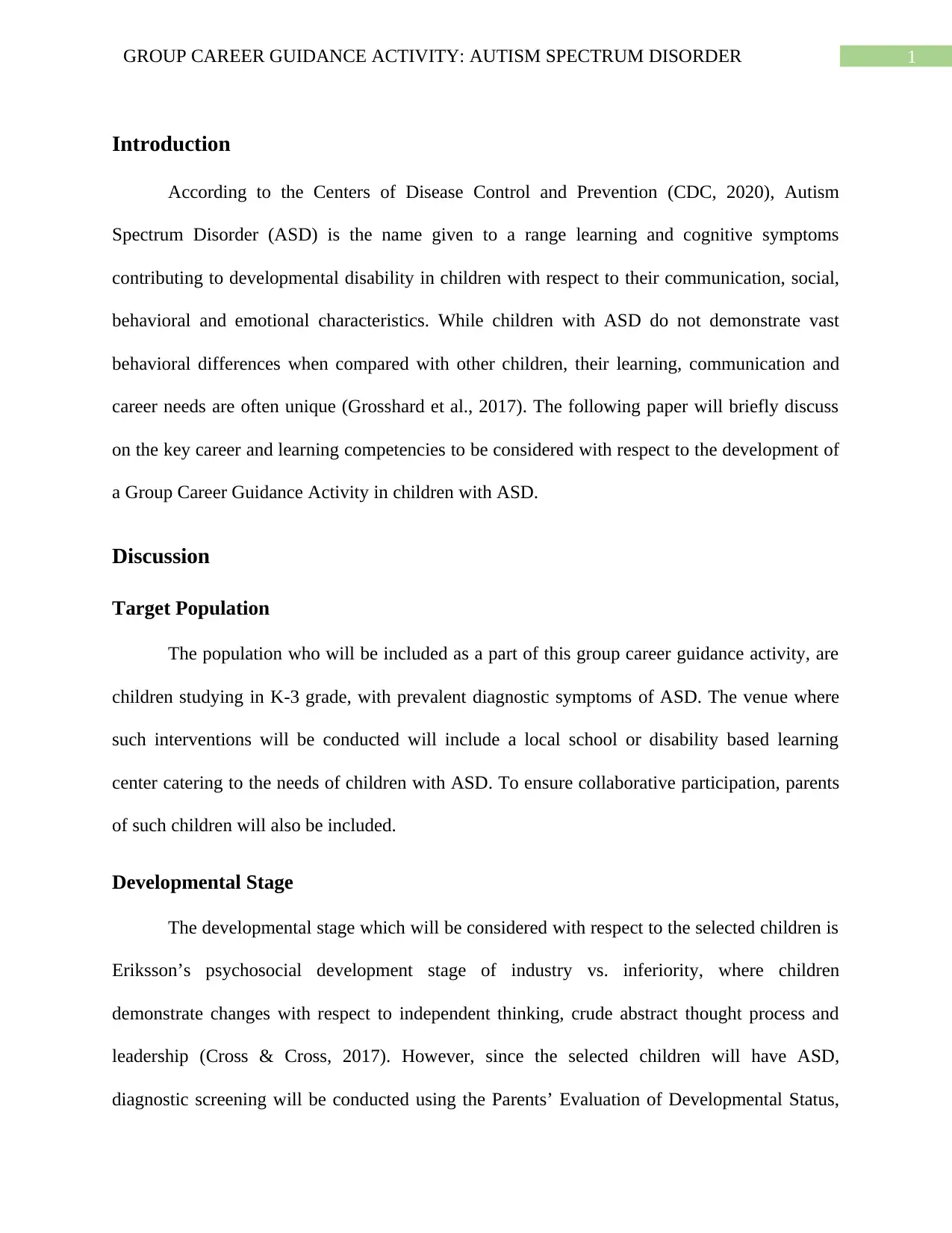
1GROUP CAREER GUIDANCE ACTIVITY: AUTISM SPECTRUM DISORDER
Introduction
According to the Centers of Disease Control and Prevention (CDC, 2020), Autism
Spectrum Disorder (ASD) is the name given to a range learning and cognitive symptoms
contributing to developmental disability in children with respect to their communication, social,
behavioral and emotional characteristics. While children with ASD do not demonstrate vast
behavioral differences when compared with other children, their learning, communication and
career needs are often unique (Grosshard et al., 2017). The following paper will briefly discuss
on the key career and learning competencies to be considered with respect to the development of
a Group Career Guidance Activity in children with ASD.
Discussion
Target Population
The population who will be included as a part of this group career guidance activity, are
children studying in K-3 grade, with prevalent diagnostic symptoms of ASD. The venue where
such interventions will be conducted will include a local school or disability based learning
center catering to the needs of children with ASD. To ensure collaborative participation, parents
of such children will also be included.
Developmental Stage
The developmental stage which will be considered with respect to the selected children is
Eriksson’s psychosocial development stage of industry vs. inferiority, where children
demonstrate changes with respect to independent thinking, crude abstract thought process and
leadership (Cross & Cross, 2017). However, since the selected children will have ASD,
diagnostic screening will be conducted using the Parents’ Evaluation of Developmental Status,
Introduction
According to the Centers of Disease Control and Prevention (CDC, 2020), Autism
Spectrum Disorder (ASD) is the name given to a range learning and cognitive symptoms
contributing to developmental disability in children with respect to their communication, social,
behavioral and emotional characteristics. While children with ASD do not demonstrate vast
behavioral differences when compared with other children, their learning, communication and
career needs are often unique (Grosshard et al., 2017). The following paper will briefly discuss
on the key career and learning competencies to be considered with respect to the development of
a Group Career Guidance Activity in children with ASD.
Discussion
Target Population
The population who will be included as a part of this group career guidance activity, are
children studying in K-3 grade, with prevalent diagnostic symptoms of ASD. The venue where
such interventions will be conducted will include a local school or disability based learning
center catering to the needs of children with ASD. To ensure collaborative participation, parents
of such children will also be included.
Developmental Stage
The developmental stage which will be considered with respect to the selected children is
Eriksson’s psychosocial development stage of industry vs. inferiority, where children
demonstrate changes with respect to independent thinking, crude abstract thought process and
leadership (Cross & Cross, 2017). However, since the selected children will have ASD,
diagnostic screening will be conducted using the Parents’ Evaluation of Developmental Status,
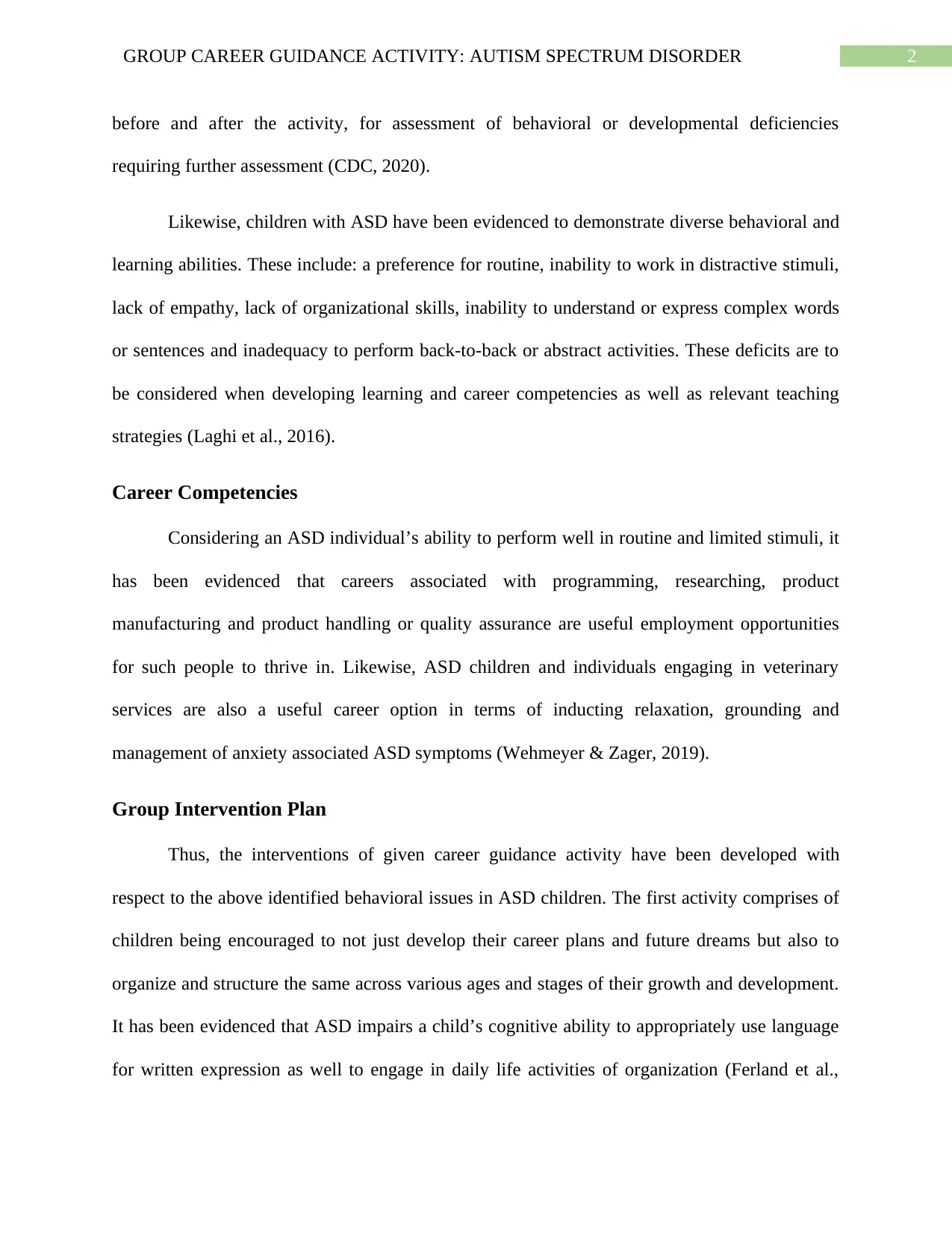
2GROUP CAREER GUIDANCE ACTIVITY: AUTISM SPECTRUM DISORDER
before and after the activity, for assessment of behavioral or developmental deficiencies
requiring further assessment (CDC, 2020).
Likewise, children with ASD have been evidenced to demonstrate diverse behavioral and
learning abilities. These include: a preference for routine, inability to work in distractive stimuli,
lack of empathy, lack of organizational skills, inability to understand or express complex words
or sentences and inadequacy to perform back-to-back or abstract activities. These deficits are to
be considered when developing learning and career competencies as well as relevant teaching
strategies (Laghi et al., 2016).
Career Competencies
Considering an ASD individual’s ability to perform well in routine and limited stimuli, it
has been evidenced that careers associated with programming, researching, product
manufacturing and product handling or quality assurance are useful employment opportunities
for such people to thrive in. Likewise, ASD children and individuals engaging in veterinary
services are also a useful career option in terms of inducting relaxation, grounding and
management of anxiety associated ASD symptoms (Wehmeyer & Zager, 2019).
Group Intervention Plan
Thus, the interventions of given career guidance activity have been developed with
respect to the above identified behavioral issues in ASD children. The first activity comprises of
children being encouraged to not just develop their career plans and future dreams but also to
organize and structure the same across various ages and stages of their growth and development.
It has been evidenced that ASD impairs a child’s cognitive ability to appropriately use language
for written expression as well to engage in daily life activities of organization (Ferland et al.,
before and after the activity, for assessment of behavioral or developmental deficiencies
requiring further assessment (CDC, 2020).
Likewise, children with ASD have been evidenced to demonstrate diverse behavioral and
learning abilities. These include: a preference for routine, inability to work in distractive stimuli,
lack of empathy, lack of organizational skills, inability to understand or express complex words
or sentences and inadequacy to perform back-to-back or abstract activities. These deficits are to
be considered when developing learning and career competencies as well as relevant teaching
strategies (Laghi et al., 2016).
Career Competencies
Considering an ASD individual’s ability to perform well in routine and limited stimuli, it
has been evidenced that careers associated with programming, researching, product
manufacturing and product handling or quality assurance are useful employment opportunities
for such people to thrive in. Likewise, ASD children and individuals engaging in veterinary
services are also a useful career option in terms of inducting relaxation, grounding and
management of anxiety associated ASD symptoms (Wehmeyer & Zager, 2019).
Group Intervention Plan
Thus, the interventions of given career guidance activity have been developed with
respect to the above identified behavioral issues in ASD children. The first activity comprises of
children being encouraged to not just develop their career plans and future dreams but also to
organize and structure the same across various ages and stages of their growth and development.
It has been evidenced that ASD impairs a child’s cognitive ability to appropriately use language
for written expression as well to engage in daily life activities of organization (Ferland et al.,
⊘ This is a preview!⊘
Do you want full access?
Subscribe today to unlock all pages.

Trusted by 1+ million students worldwide
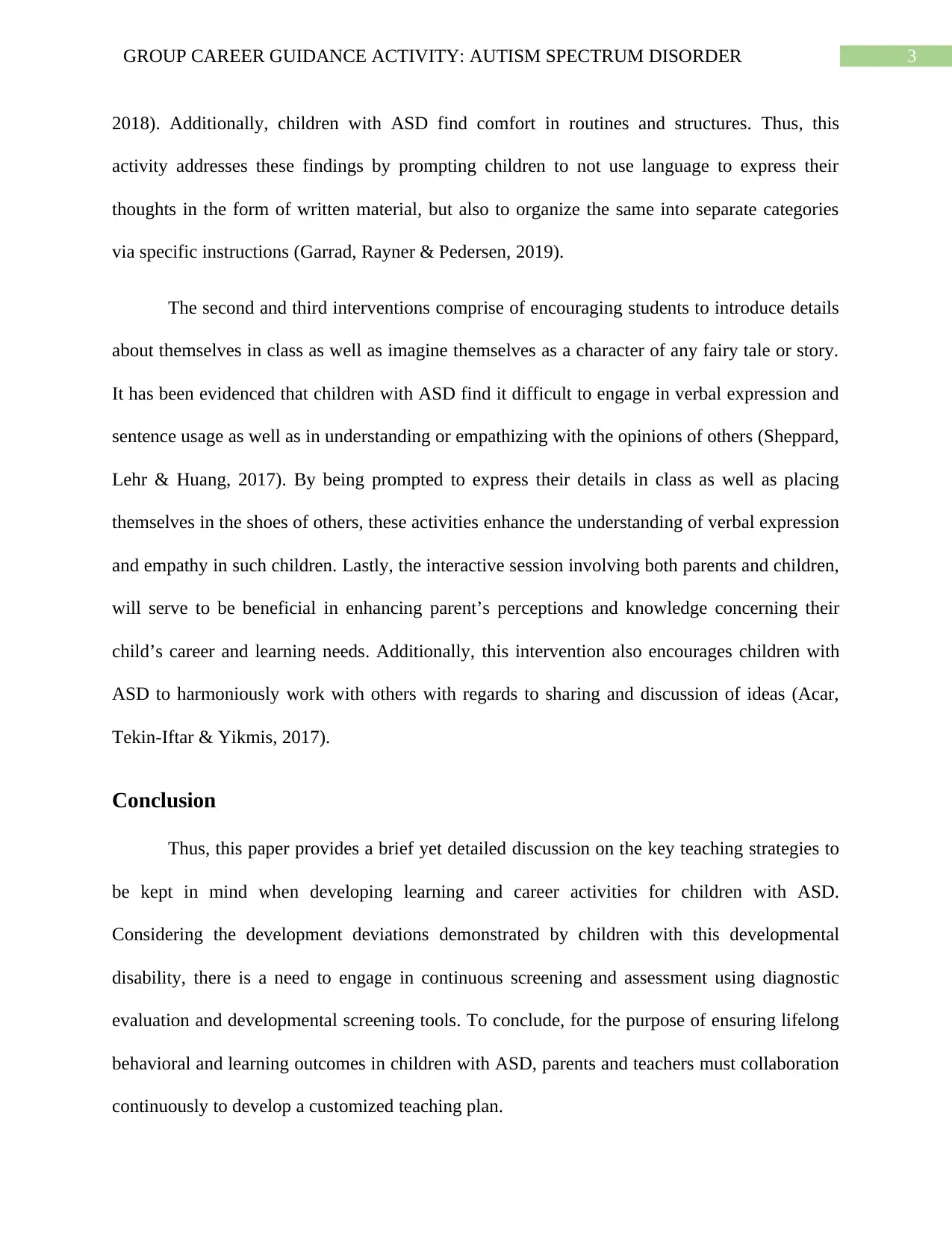
3GROUP CAREER GUIDANCE ACTIVITY: AUTISM SPECTRUM DISORDER
2018). Additionally, children with ASD find comfort in routines and structures. Thus, this
activity addresses these findings by prompting children to not use language to express their
thoughts in the form of written material, but also to organize the same into separate categories
via specific instructions (Garrad, Rayner & Pedersen, 2019).
The second and third interventions comprise of encouraging students to introduce details
about themselves in class as well as imagine themselves as a character of any fairy tale or story.
It has been evidenced that children with ASD find it difficult to engage in verbal expression and
sentence usage as well as in understanding or empathizing with the opinions of others (Sheppard,
Lehr & Huang, 2017). By being prompted to express their details in class as well as placing
themselves in the shoes of others, these activities enhance the understanding of verbal expression
and empathy in such children. Lastly, the interactive session involving both parents and children,
will serve to be beneficial in enhancing parent’s perceptions and knowledge concerning their
child’s career and learning needs. Additionally, this intervention also encourages children with
ASD to harmoniously work with others with regards to sharing and discussion of ideas (Acar,
Tekin-Iftar & Yikmis, 2017).
Conclusion
Thus, this paper provides a brief yet detailed discussion on the key teaching strategies to
be kept in mind when developing learning and career activities for children with ASD.
Considering the development deviations demonstrated by children with this developmental
disability, there is a need to engage in continuous screening and assessment using diagnostic
evaluation and developmental screening tools. To conclude, for the purpose of ensuring lifelong
behavioral and learning outcomes in children with ASD, parents and teachers must collaboration
continuously to develop a customized teaching plan.
2018). Additionally, children with ASD find comfort in routines and structures. Thus, this
activity addresses these findings by prompting children to not use language to express their
thoughts in the form of written material, but also to organize the same into separate categories
via specific instructions (Garrad, Rayner & Pedersen, 2019).
The second and third interventions comprise of encouraging students to introduce details
about themselves in class as well as imagine themselves as a character of any fairy tale or story.
It has been evidenced that children with ASD find it difficult to engage in verbal expression and
sentence usage as well as in understanding or empathizing with the opinions of others (Sheppard,
Lehr & Huang, 2017). By being prompted to express their details in class as well as placing
themselves in the shoes of others, these activities enhance the understanding of verbal expression
and empathy in such children. Lastly, the interactive session involving both parents and children,
will serve to be beneficial in enhancing parent’s perceptions and knowledge concerning their
child’s career and learning needs. Additionally, this intervention also encourages children with
ASD to harmoniously work with others with regards to sharing and discussion of ideas (Acar,
Tekin-Iftar & Yikmis, 2017).
Conclusion
Thus, this paper provides a brief yet detailed discussion on the key teaching strategies to
be kept in mind when developing learning and career activities for children with ASD.
Considering the development deviations demonstrated by children with this developmental
disability, there is a need to engage in continuous screening and assessment using diagnostic
evaluation and developmental screening tools. To conclude, for the purpose of ensuring lifelong
behavioral and learning outcomes in children with ASD, parents and teachers must collaboration
continuously to develop a customized teaching plan.
Paraphrase This Document
Need a fresh take? Get an instant paraphrase of this document with our AI Paraphraser
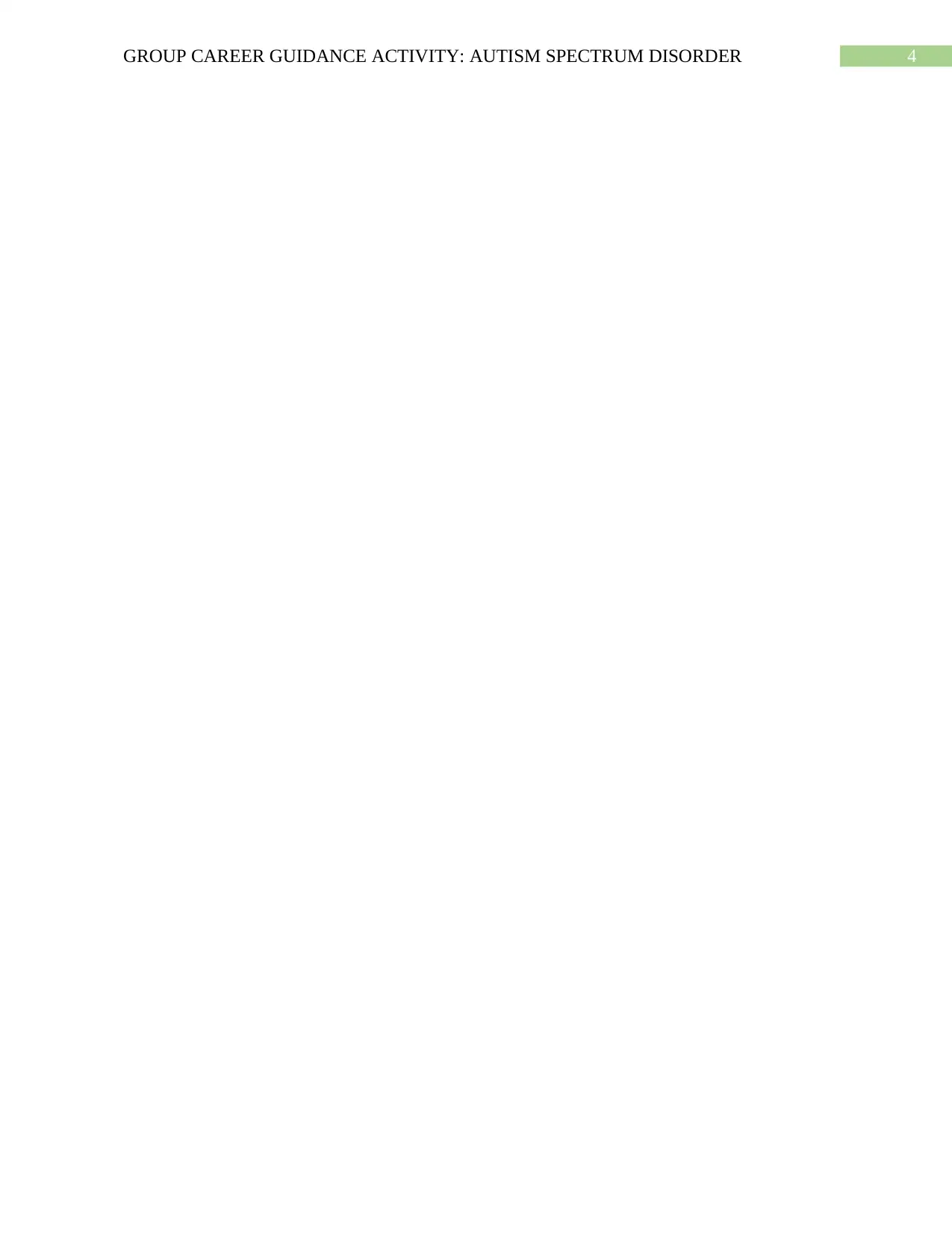
4GROUP CAREER GUIDANCE ACTIVITY: AUTISM SPECTRUM DISORDER
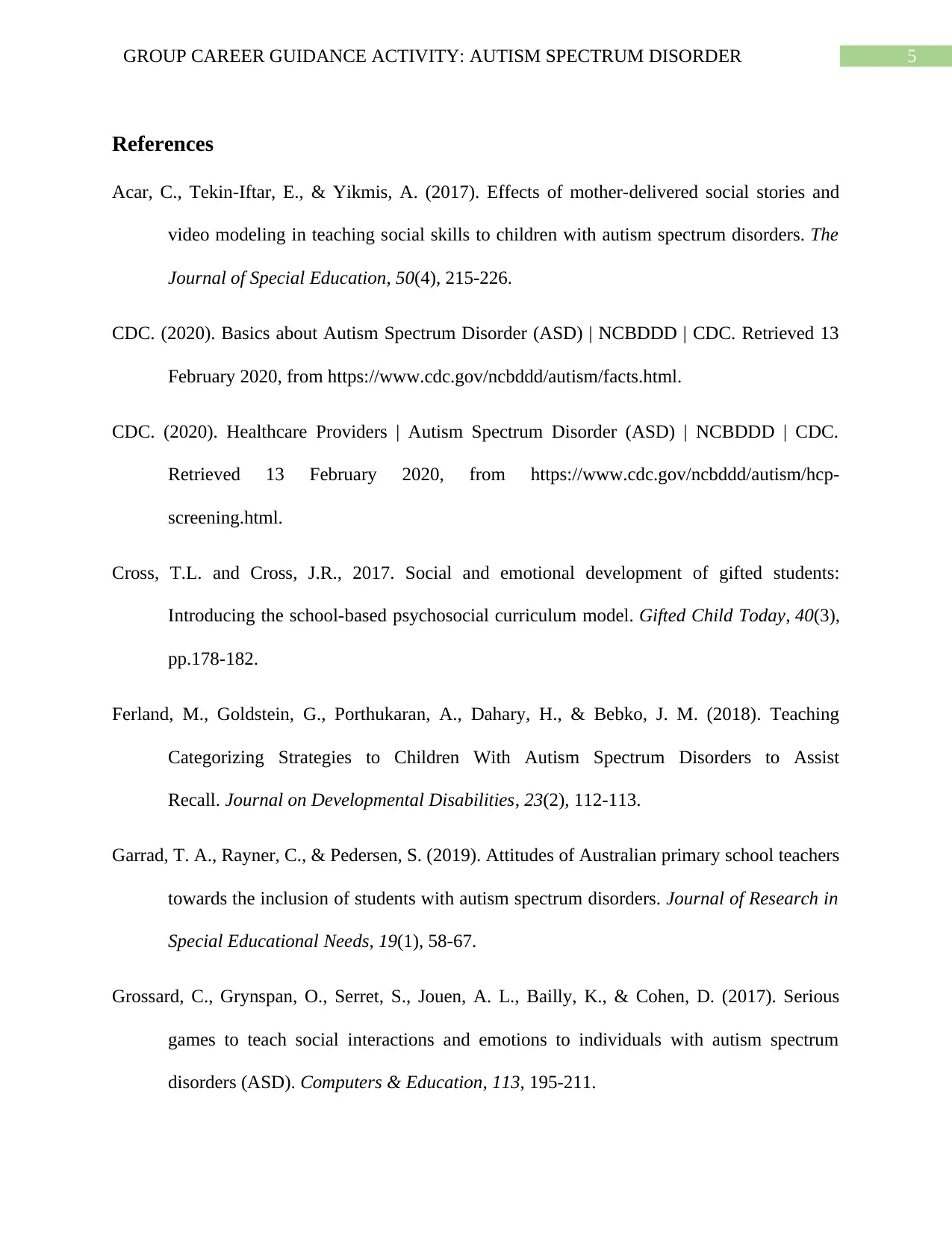
5GROUP CAREER GUIDANCE ACTIVITY: AUTISM SPECTRUM DISORDER
References
Acar, C., Tekin-Iftar, E., & Yikmis, A. (2017). Effects of mother-delivered social stories and
video modeling in teaching social skills to children with autism spectrum disorders. The
Journal of Special Education, 50(4), 215-226.
CDC. (2020). Basics about Autism Spectrum Disorder (ASD) | NCBDDD | CDC. Retrieved 13
February 2020, from https://www.cdc.gov/ncbddd/autism/facts.html.
CDC. (2020). Healthcare Providers | Autism Spectrum Disorder (ASD) | NCBDDD | CDC.
Retrieved 13 February 2020, from https://www.cdc.gov/ncbddd/autism/hcp-
screening.html.
Cross, T.L. and Cross, J.R., 2017. Social and emotional development of gifted students:
Introducing the school-based psychosocial curriculum model. Gifted Child Today, 40(3),
pp.178-182.
Ferland, M., Goldstein, G., Porthukaran, A., Dahary, H., & Bebko, J. M. (2018). Teaching
Categorizing Strategies to Children With Autism Spectrum Disorders to Assist
Recall. Journal on Developmental Disabilities, 23(2), 112-113.
Garrad, T. A., Rayner, C., & Pedersen, S. (2019). Attitudes of Australian primary school teachers
towards the inclusion of students with autism spectrum disorders. Journal of Research in
Special Educational Needs, 19(1), 58-67.
Grossard, C., Grynspan, O., Serret, S., Jouen, A. L., Bailly, K., & Cohen, D. (2017). Serious
games to teach social interactions and emotions to individuals with autism spectrum
disorders (ASD). Computers & Education, 113, 195-211.
References
Acar, C., Tekin-Iftar, E., & Yikmis, A. (2017). Effects of mother-delivered social stories and
video modeling in teaching social skills to children with autism spectrum disorders. The
Journal of Special Education, 50(4), 215-226.
CDC. (2020). Basics about Autism Spectrum Disorder (ASD) | NCBDDD | CDC. Retrieved 13
February 2020, from https://www.cdc.gov/ncbddd/autism/facts.html.
CDC. (2020). Healthcare Providers | Autism Spectrum Disorder (ASD) | NCBDDD | CDC.
Retrieved 13 February 2020, from https://www.cdc.gov/ncbddd/autism/hcp-
screening.html.
Cross, T.L. and Cross, J.R., 2017. Social and emotional development of gifted students:
Introducing the school-based psychosocial curriculum model. Gifted Child Today, 40(3),
pp.178-182.
Ferland, M., Goldstein, G., Porthukaran, A., Dahary, H., & Bebko, J. M. (2018). Teaching
Categorizing Strategies to Children With Autism Spectrum Disorders to Assist
Recall. Journal on Developmental Disabilities, 23(2), 112-113.
Garrad, T. A., Rayner, C., & Pedersen, S. (2019). Attitudes of Australian primary school teachers
towards the inclusion of students with autism spectrum disorders. Journal of Research in
Special Educational Needs, 19(1), 58-67.
Grossard, C., Grynspan, O., Serret, S., Jouen, A. L., Bailly, K., & Cohen, D. (2017). Serious
games to teach social interactions and emotions to individuals with autism spectrum
disorders (ASD). Computers & Education, 113, 195-211.
⊘ This is a preview!⊘
Do you want full access?
Subscribe today to unlock all pages.

Trusted by 1+ million students worldwide
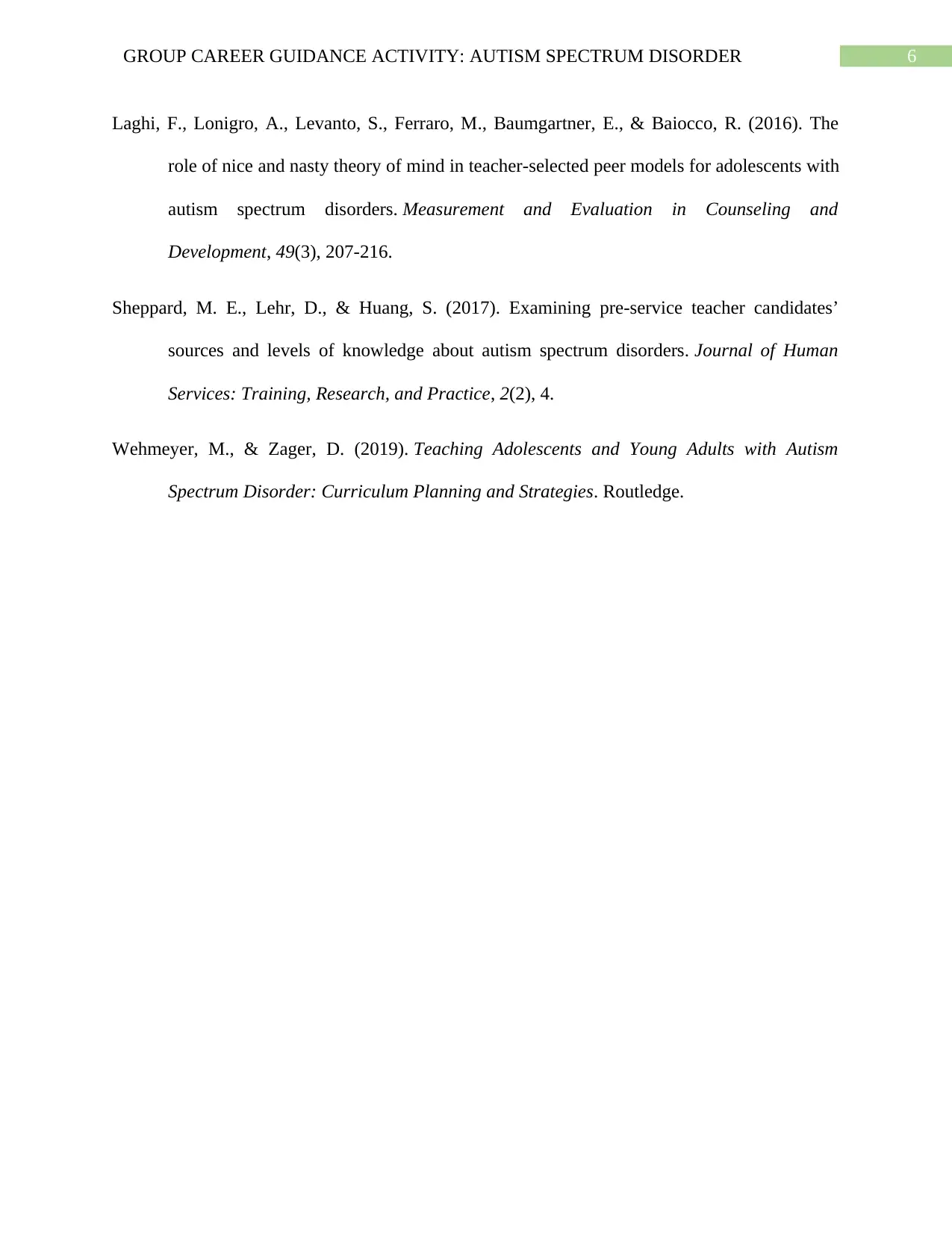
6GROUP CAREER GUIDANCE ACTIVITY: AUTISM SPECTRUM DISORDER
Laghi, F., Lonigro, A., Levanto, S., Ferraro, M., Baumgartner, E., & Baiocco, R. (2016). The
role of nice and nasty theory of mind in teacher-selected peer models for adolescents with
autism spectrum disorders. Measurement and Evaluation in Counseling and
Development, 49(3), 207-216.
Sheppard, M. E., Lehr, D., & Huang, S. (2017). Examining pre-service teacher candidates’
sources and levels of knowledge about autism spectrum disorders. Journal of Human
Services: Training, Research, and Practice, 2(2), 4.
Wehmeyer, M., & Zager, D. (2019). Teaching Adolescents and Young Adults with Autism
Spectrum Disorder: Curriculum Planning and Strategies. Routledge.
Laghi, F., Lonigro, A., Levanto, S., Ferraro, M., Baumgartner, E., & Baiocco, R. (2016). The
role of nice and nasty theory of mind in teacher-selected peer models for adolescents with
autism spectrum disorders. Measurement and Evaluation in Counseling and
Development, 49(3), 207-216.
Sheppard, M. E., Lehr, D., & Huang, S. (2017). Examining pre-service teacher candidates’
sources and levels of knowledge about autism spectrum disorders. Journal of Human
Services: Training, Research, and Practice, 2(2), 4.
Wehmeyer, M., & Zager, D. (2019). Teaching Adolescents and Young Adults with Autism
Spectrum Disorder: Curriculum Planning and Strategies. Routledge.
1 out of 7
Related Documents
Your All-in-One AI-Powered Toolkit for Academic Success.
+13062052269
info@desklib.com
Available 24*7 on WhatsApp / Email
![[object Object]](/_next/static/media/star-bottom.7253800d.svg)
Unlock your academic potential
Copyright © 2020–2025 A2Z Services. All Rights Reserved. Developed and managed by ZUCOL.




